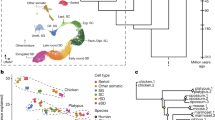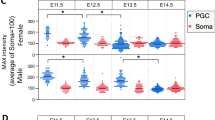Abstract
Spermatogonia are the self-renewing, mitotic germ cells of the testis from which sperm arise by means of the differentiation pathway known as spermatogenesis1. By contrast with hematopoietic and other mammalian stem-cell populations, which have been subjects of intense molecular genetic investigation, spermatogonia have remained largely unexplored at the molecular level. Here we describe a systematic search for genes expressed in mouse spermatogonia, but not in somatic tissues. We identified 25 genes (19 of which are novel) that are expressed in only male germ cells. Of the 25 genes, 3 are Y-linked and 10 are X-linked. If these genes had been distributed randomly in the genome, one would have expected zero to two of the genes to be X-linked. Our findings indicate that the X chromosome has a predominant role in pre-meiotic stages of mammalian spermatogenesis. We hypothesize that the X chromosome acquired this prominent role in male germ-cell development as it evolved from an ordinary, unspecialized autosome.
This is a preview of subscription content, access via your institution
Access options
Subscribe to this journal
Receive 12 print issues and online access
$209.00 per year
only $17.42 per issue
Buy this article
- Purchase on Springer Link
- Instant access to full article PDF
Prices may be subject to local taxes which are calculated during checkout



Similar content being viewed by others
Accession codes
Accessions
GenBank/EMBL/DDBJ
References
de Rooij, D.G. & Grootegoed, J.A. Spermatogonial stem cells. Curr. Opin. Cell Biol. 10, 694–701 (1998).
Diatchenko, L. et al. Suppression subtractive hybridization: a method for generating differentially regulated or tissue-specific cDNA probes and libraries. Proc. Natl. Acad. Sci. USA 93, 6025–6030 (1996).
Lavery, D.J., Lopez-Molina, L., Fleury-Olela, F. & Schibler, U. Selective amplification via biotin- and restriction-mediated enrichment (SABRE), a novel selective amplification procedure for detection of differentially expressed mRNAs. Proc. Natl. Acad. Sci. USA 94, 6831–6836 (1997).
Bellve, A.R. Purification, culture, and fractionation of spermatogenic cells. Methods Enzymol. 225, 84–113 (1993).
Morrison-Graham, K. & Takahashi, Y. Steel factor and c-kit receptor: from mutants to a growth factor system. Bioessays 15, 77–83 (1993).
Cooke, H.J., Lee, M., Kerr, S. & Ruggiu, M. A murine homologue of the human DAZ gene is autosomal and expressed only in male and female gonads. Hum. Mol. Genet. 5, 513–516 (1996).
Reijo, R. et al. Mouse autosomal homolog of DAZ, a candidate male sterility gene in humans, is expressed in male germ cells before and after puberty. Genomics 35, 346–352 (1996).
Elliott, D.J. et al. An RBM homologue maps to the mouse Y chromosome and is expressed in germ cells. Hum. Mol. Genet. 5, 869–874 (1996).
Rongo, C. & Lehmann, R. Regulated synthesis, transport and assembly of the Drosophila germ plasm. Trends Genet. 12, 102–109 (1996).
Seydoux, G. & Strome, S. Launching the germline in Caenorhabditis elegans: regulation of gene expression in early germ cells. Development 126, 3275–3283 (1999).
Foster, J.W. & Graves, J.A. An SRY-related sequence on the marsupial X chromosome: implications for the evolution of the mammalian testis-determining gene. Proc. Natl. Acad. Sci. USA 91, 1927–1931 (1994).
Lahn, B.T. & Page, D.C. Four evolutionary strata on the human X chromosome. Science 286, 964–967 (1999).
Graves, J.A.M., Disteche, C.M. & Toder, R. Gene dosage in the evolution and function of mammalian sex chromosomes. Cytogenet. Cell Genet. 80, 94–103 (1998).
Jegalian, K. & Page, D.C. A proposed path by which genes common to mammalian X and Y chromosomes evolve to become X inactivated. Nature 394, 776–780 (1998).
Frank, S.A. Divergence of meiotic drive-suppression systems as an explanation for sex-biased hybrid sterility and inviability. Evolution 45, 262–267 (1991).
Hurst, L.D. & Pomiankowski, A. Causes of sex ratio bias may account for unisexual sterility in hybrids: a new explanation of Haldane's rule and related phenomena. Genetics 128, 841–858 (1991).
Charlesworth, B., Coyne, J.A. & Orr, H.A. Meiotic drive and unisexual hybrid sterility: a comment. Genetics 133, 421–432 (1993).
Fisher, R.A. The evolution of dominance. Biol. Rev. 6, 345–368 (1931).
Rice, W.R. Sex-chromosomes and the evolution of sexual dimorphism. Evolution 38, 735–742 (1984).
Hurst, L.D. & Randerson, J.P. An eXceptional chromosome. Trends Genet. 15, 383–385 (1999).
Herrmann, B.G., Koschorz, B., Wertz, K., McLaughlin, K.J. & Kispert, A. A protein kinase encoded by the t complex responder gene causes non-mendelian inheritance. Nature 402, 141–146 (1999).
Saxena, R. et al. The DAZ gene cluster on the human Y chromosome arose from an autosomal gene that was transposed, repeatedly amplified and pruned. Nature Genet. 14, 292–299 (1996).
Rice, W.R. Sexually antagonistic genes: experimental evidence. Science 256, 1436–1439 (1992).
Brooks, R. Negative genetic correlation between male sexual attractiveness and survival. Nature 406, 67–70 (2000).
Sun, C. et al. An azoospermic man with a de novo point mutation in the Y-chromosomal gene USP9Y. Nature Genet. 23, 429–432 (1999).
Ma, K. et al. A Y chromosome gene family with RNA-binding protein homology: candidates for the azoospermia factor AZF controlling human spermatogenesis. Cell 75, 1287–1295 (1993).
Reijo, R. et al. Diverse spermatogenic defects in humans caused by Y chromosome deletions encompassing a novel RNA-binding protein gene. Nature Genet. 10, 383–393 (1995).
McCarthy, L.C. et al. A first-generation whole genome-radiation hybrid map spanning the mouse genome. Genome Res. 7, 1153–1161 (1997).
Van Etten, W.J. et al. Radiation hybrid map of the mouse genome. Nature Genet. 22, 384–387 (1999).
Bergstrom, D.E. et al. The mouse Y chromosome: enrichment, sizing, and cloning by bivariate flow cytometry. Genomics 48, 304–313 (1998).
Acknowledgements
We thank D. Menke for developing the subtraction protocol; H. Skaletsky for statistical advice and bioinformatics support; and A. Arango, D. Berry, A. Bortvin, D. Charlesworth, B. Charlesworth, A. Chess, A. Clark, C. Disteche, L. Goldmakher, D. Haig, M. Handel, R. Jaenisch, T. Kawaguchi, F. Lewitter, B. Lahn, A. Lin, D. Menke, T. Rasmussen, W. Rice, S. Rozen and S. Silber for comments on the manuscript. Supported by National Institutes of Health. P.J.W. was the recipient of a Lalor Foundation fellowship.
Author information
Authors and Affiliations
Corresponding author
Supplementary information
Rights and permissions
About this article
Cite this article
Wang, P., McCarrey, J., Yang, F. et al. An abundance of X-linked genes expressed in spermatogonia. Nat Genet 27, 422–426 (2001). https://doi.org/10.1038/86927
Received:
Accepted:
Issue Date:
DOI: https://doi.org/10.1038/86927
This article is cited by
-
Synergistic enhancement of the mouse Pramex1 and Pramel1 in repressing retinoic acid (RA) signaling during gametogenesis
Cell & Bioscience (2024)
-
Single-cell profiling of Anopheles gambiae spermatogenesis defines the onset of meiotic silencing and premeiotic overexpression of the X chromosome
Communications Biology (2023)
-
The osteoprotective role of USP26 in coordinating bone formation and resorption
Cell Death & Differentiation (2022)
-
Mammalian X-chromosome inactivation: proposed role in suppression of the male programme in genetic females
Journal of Genetics (2022)
-
Association of ESX1 gene variants with non-obstructive azoospermia in Chinese males
Scientific Reports (2021)



